An unpretentious variety with an unusual color and unique taste - the Black Prince tomato and the features of its cultivation
Summer residents love to experiment with the plants they grow in their garden beds. Unusual shapes and colors of vegetables attract the attention of gardeners, and a high yield of fruits that are unusual to our eyes evokes a feeling of pride and envy among neighbors.
Try planting Black Prince chokeberry tomatoes on your plot. You will receive not only unusual-looking tomatoes, but also amazingly sweet tomatoes that are easy to grow. In our review, read the characteristics and description of the variety, cultivation features and techniques used by farmers to obtain a larger harvest.
Description of the variety
We were unable to find exact information about the company that originated the variety. It is known that tomatoes were included in the State Register of the Russian Federation in 2000. A few years later, an f1 hybrid with the same name appeared, so before purchasing, carefully study the packaging - it will indicate whether you are buying varietal or hybrid seeds. The difference between them is that seeds can be collected from varietal tomatoes for subsequent planting, but the hybrid will not produce a harvest in the second generation.
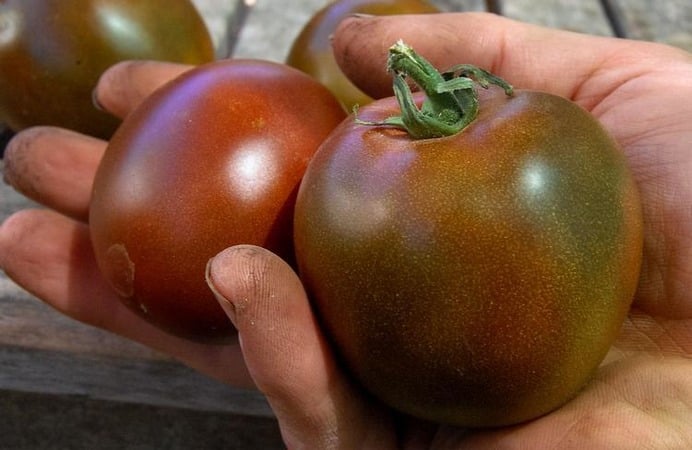
Tomatoes are grown in different climatic zones of our country in shelters and open ground.
The dark skin color, unusual for these vegetables, gives the tomato the anthocyanin it contains.
Important! It is not entirely true to say that black tomatoes exist. In fact, due to the pigment, the skin and pulp acquire a brown-green to brown-red-brown color.Sometimes only the skin acquires a blue-violet color, while the flesh remains red.
Distinctive features
Mid-season, indeterminate variety. The bush reaches a height of 1.5-2.5 m. The first fruits ripen on the bush at 110-120 days. The stem is strong, the leaves are light green, tomato-type. The roots of the plant grow wider.
Inflorescences are formed after 7-9 pairs of leaves, higher - after every third pair. No more than 5-6 flowers are left on the ovary.
Fruit characteristics and yield
In the photo below you will see what color Black Prince tomatoes have.
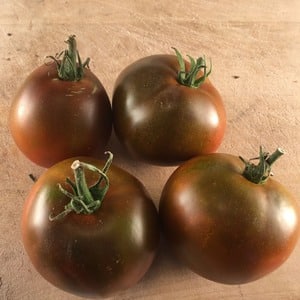
Other characteristics:
- round, flattened at the top and bottom, multi-ribbed shape;
- the pulp is juicy, fleshy, burgundy in color;
- the skin is smooth, thin;
- sweet, tomato taste and aroma;
- average fruit weight – from 100 to 500 g;
- yield - 7 kg per 1 sq. m (3-4 bushes).
How to grow seedlings
Seeds are sown for seedlings 60-65 days before transplanting into the ground.
Seed preparation
Proper seed preparation will allow you to grow viable seedlings:
- Calibration. Pour out the seeds and examine them. Select dense, large, even ones that do not feel empty to the touch. Place them in a saline solution. To do this, dissolve 1 tablespoon of salt in a glass of water. The duration of the procedure is 15-20 minutes. Select the seeds that have sunk to the bottom for planting, and discard those that have floated to the surface.
- Warming up. Place the grains on a cloth on a central heating radiator and keep warm for 36-48 hours. There is another way: a few months before sowing, hang a bag of seeds on the radiator.
- Disinfection. Prepare a 1% solution of potassium permanganate: dissolve 1 level teaspoon of potassium permanganate in 3 glasses of water. Place the seeds in the solution for 15-20 minutes, then rinse with clean running water.Disinfection is mandatory for self-collected seeds. However, remember that it will not destroy the infection inside the seed, it will only kill the pathogens that live on the surface.
- Bubbling. Simply put, this procedure is called “oxygenation.” Place the seeds in water heated to +26...+30 °C and stir them every hour or use an aquarium compressor. Stop bubbling after 15-18 hours or as soon as the grains begin to develop germs.
- Soak. Place the planting material in warm (+20 °C) water. Add any of the biostimulating drugs to it: “Zircon”, “Epin”, “Immunocytophyte”. Some summer residents recommend honey soaking. Dissolve a teaspoon of honey in a glass of cool water. Place the seeds on a cloth or gauze, pour 3-5 tablespoons of the solution on them and wrap the cloth in an envelope. The duration of the procedure is 3-12 hours; as the fabric dries, moisten it with the solution.
- Hardening. Wrap the grains in cotton cloth and plastic wrap and place in a cool place where the temperature reaches -3...+2 °C (refrigerator, balcony). Alternate the temperature regime: 8 hours in the cold, 8 hours in the heat. Repeat changing temperatures 5-6 times. If you are not sure that you will carry out the hardening procedure correctly, or are afraid of spoiling the seeds, skip this stage of preparation.
- Germination. Place the grains on a cloth or gauze on a flat, shallow dish (Petri dish, saucer, lid). Wet the cloth with warm water and place the container with the seeds in a warm (+25 ° C) place. Make sure the fabric remains damp at all times.
Container and soil
Use special containers or cut-off PET bottles and cups as pots for seedlings.
Buy soil at the store - universal soil for tomatoes.It contains humus, peat and river sand.
To prepare your own soil, combine:
- peat – 7 parts;
- sawdust – 1 part;
- turf soil - 1 part;
or
- peat – 3 parts;
- humus – 1 part;
- mullein and humus - 0.5 parts.
Treat the planting containers and soil with a solution of potassium permanganate.
Sowing
Moisten the soil. Sow seeds every 2-3 cm. Sprinkle with a 1.5-2 cm layer of soil. Cover the containers with film and place in a warm, bright place. Ventilate the mini-greenhouses daily and, as the soil dries out, moisten it with a spray bottle or syringe so as not to wash out the seeds.
Shoots appear on day 10-12, then remove the film.
Growing and care
In the phase of 2-3 true leaves, pick up the plants: plant them in separate containers so that the seedlings can grow a root system. After picking, place the seedlings in the shade for 2-3 days. Maintain the temperature at 22-24 °C.
Water the tomatoes as the soil dries, strictly at the root, with warm, settled water.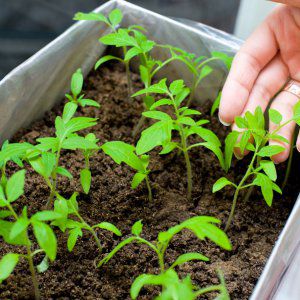
If you notice that the seedlings are stretching, this means that they do not have enough light. Illuminate plants with fluorescent or LED lamps. Place them strictly on top of the seedlings.
Change the location of the lamps if:
- There are burns on the leaves - increase the distance between the lamps and the plants.
- The leaves have become paler and the stem has become longer - bring the light source closer.
In 10-14 days, start hardening the seedlings. To begin with, take it outside during the day for 3-4 hours, adding an hour each day. 2 days before planting in the beds, leave the seedlings overnight to acclimate them to possible night cold snaps.
How to grow tomatoes
Tomatoes are transplanted into beds in May: in the middle of the month - into greenhouses, at the end - into open ground.If you are afraid of sudden temperature changes, cover the beds with covering material. Once permanent positive weather has established, it can be removed.
Landing
A day before planting, treat the soil with a solution of potassium permanganate or boiling water to destroy possible infections or pest larvae.
If you did not apply fertilizer in the fall, apply it before planting: 50 g of ammonium nitrate and 100 g of wood ash per bush. Plant tall seedlings at an angle. Then water the bushes with warm water.
Planting pattern – 40×60 cm.
Care
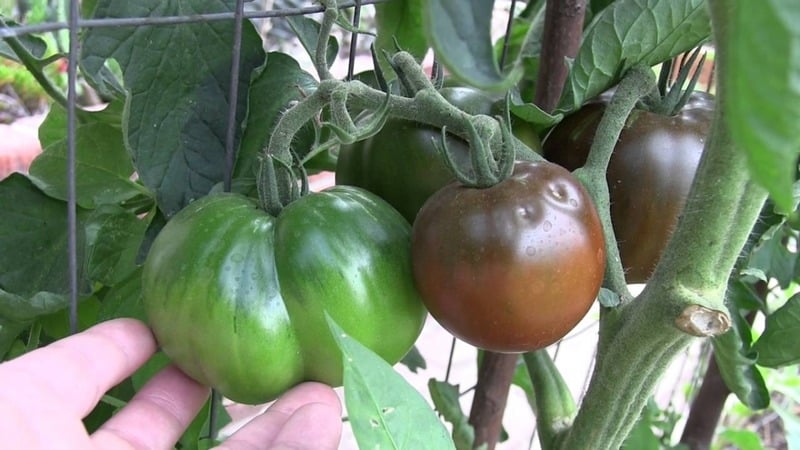
Tomatoes love frequent watering. Water the bushes at the root: in hot weather - early in the morning, in cloudy weather - both in the morning and during the day.
After watering, water the weeds and hill up the bushes so that the root system has access to oxygen.
Fertilize your tomatoes every two weeks. Alternate two types of fertilizing: root and foliar.
Add to the root:
- humus;
- manure diluted with water.
For foliage use:
- calcium nitrate;
- urea;
- monopotassium phosphate;
- "Epin";
- "Immunocytophyte".
Important! Summer residents note that with foliar feeding, nutrients are absorbed faster by plants (in 2-4 hours versus 2-4 days with root feeding), the ability of leaves to resist tomato diseases and harmful insects increases, 15-20% more inflorescences are formed, fruits ripen within a week earlier.
Do not spray tomatoes during the day in hot weather to prevent the plants from getting sunburn.
Form the black prince into 1-2 stems. At the end of July - beginning of August, pinch the top.
Due to the tall stem and heaviness of the fruit, it is necessary tie up tomatoes as they grow.
Features of cultivation and possible difficulties
Black Prince tomatoes are self-pollinating, so plant them at a distance of 1-2 m from other varieties. IN Otherwise, cross-pollination and a change in the quality of tomatoes is possible.
One of the difficulties gardeners who have already tried to grow the Black Prince variety include watering. As we have already said, the variety loves moisture and needs frequent and abundant watering, but excess water is also harmful: the plants will get sick and the fruits will crack. Focus on weather conditions to choose the optimal frequency of watering.
Diseases and pests
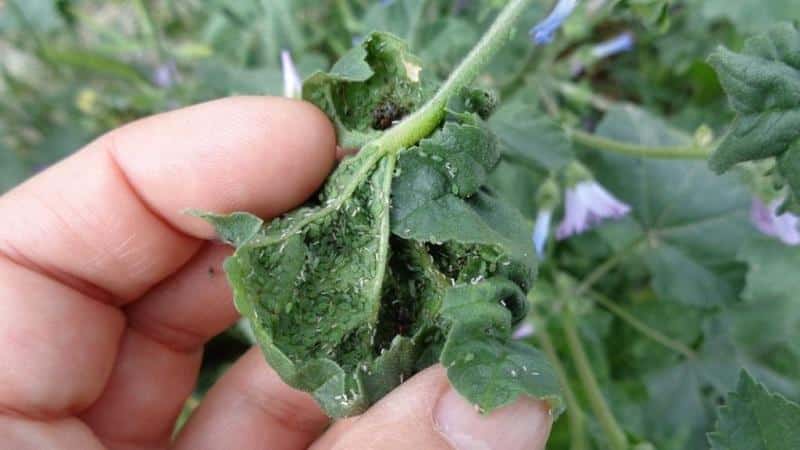
Manufacturers claim that tomatoes are moderately resistant to diseases. To prevent fungal diseases in greenhouses or in cool, frequent summers in open ground, treat plantings with Fitosporin.
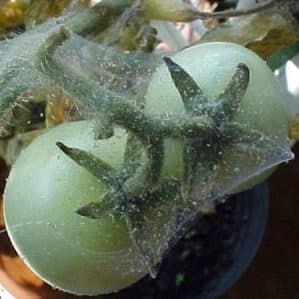
In hot summers, tomatoes are attacked by spider mites, aphids or thrips. From aphids and thrips use the drug "Bison", for spider mites - "Apollo".
Carry out treatment with any preparations in dry, windless weather. Preventive and medicinal products must remain on the leaves for at least 24 hours.
The nuances of growing in open ground and in a greenhouse
When growing tomatoes, remember that every year you need to either change the location of the greenhouse (if it is portable), or disinfect the soil using potassium permanganate or boiling water and change the top layer of soil (if the greenhouse is stationary).
In a greenhouse, pinch the bush after 7 clusters, in an open garden bed - after 5, so that the fruits have time to ripen before the onset of cold weather.
When growing indoors, pay special attention to ventilation and frequency of watering. Don’t be lazy and check how dry the soil is before each watering.
Harvesting and application
Harvest tomatoes at 110-120 days. Use fresh fruits within 10-14 days.Whole tomatoes are not suitable for long-term storage, transportation and pickling because of their skin, which cracks easily, but they are ideal for lecho and canned salads. They are also not used in juice production due to the increased dryness of the fruit; some summer residents use it for sauces and ketchups.
Important! If the fruits on the upper branches do not have time to ripen before the onset of cold weather, remove them and set them aside for ripening or use them in preparing snacks.
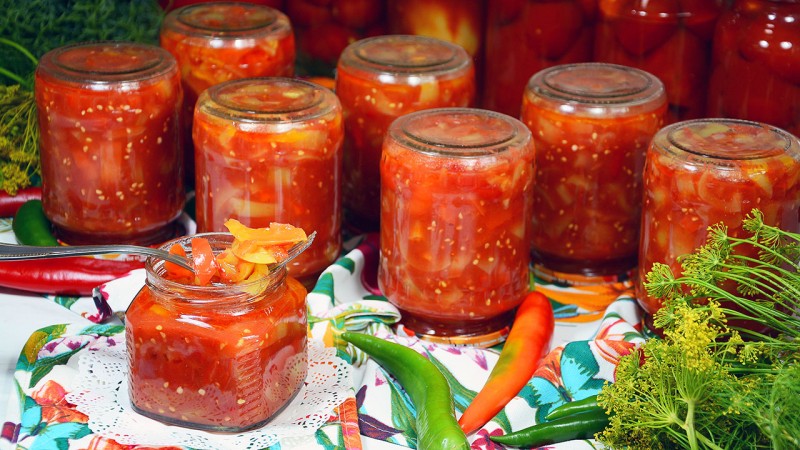
Advantages and disadvantages of the variety
Russian gardeners fell in love with the Black Prince variety for its unusual color and ease of cultivation. The advantages also include:
- mid-ripening;
- immunity to tomato diseases;
- high yield (7 kg from 3-4 bushes);
- taste qualities.
The disadvantages include:
- need for molding;
- frequent watering;
- impossibility of long-term storage and transportation.
Farmer reviews
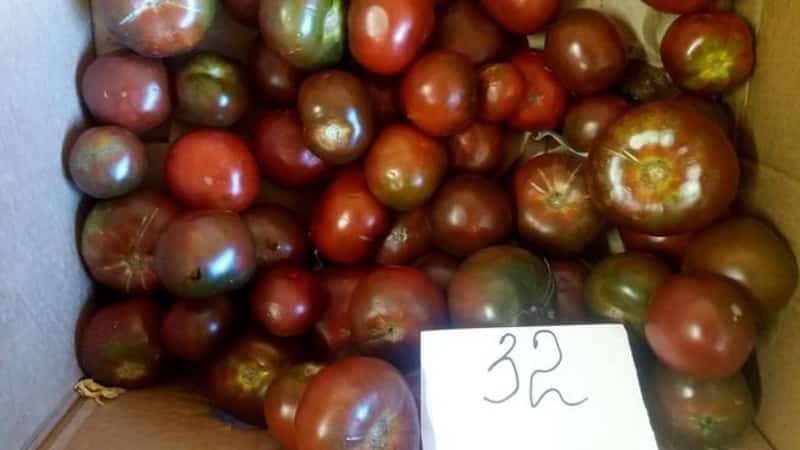
In their reviews, summer residents note that tomatoes have a sweet taste. In the southern and central regions they produce a bountiful harvest, but in the north of Russia the yield falls.
Nikolay Sychkin, Oryol region: “I grow these tomatoes every year at the dacha; they don’t require too much effort, they’re unpretentious, and the harvest is pleasing to the eye. I carry a bucket home almost every day. They grow, occupy a small area, and there are enough ripe tomatoes for our entire large family.”
Alina Soldatova, Ural: “I like the Black Prince tomato variety. The taste is sweet, I eat these tomatoes just like fruit. Very tasty. It is, yes, a little difficult to grow - I can’t say that they are more susceptible to diseases or pests, but it doesn’t yield enough on the bush. And seedlings are difficult to grow - they are whimsical. Plus the seeds in a bag - one or two and it’s gone.”
Daria Nosova, Rostov region: “I don’t know why everyone is up in arms about this variety of tomatoes. I always grow several bushes. Last year they ripened first (!!!), a week earlier than the frankly early varieties. We picked the first ripe tomato (weighing 270 grams!) on July 10. In a salad it is both beautiful and tasty. The pulp is juicy, soft, velvety. It doesn’t go to waste - that’s true. It cracks due to ripeness. But it’s good when there are DIFFERENT varieties for different delicious dishes. One of these days I’ll take a photo on a bush and be sure to post it. So, I am FOR the Black Prince!”
Conclusion
Black Prince tomatoes are suitable for growing in both open and closed beds, but in the Urals and Siberia it is recommended to grow it in greenhouses. The bushes are formed into 1-2 stems, after 5-7 stems they are pinched so that the fruits have time to ripen. Productivity – 7 kg per 1 sq. m. Black fruits weighing 100-300 g are used fresh.
They cannot be stored or transported for a long time due to their delicate, easily bursting skin. For the same reason, tomatoes are not used for whole-fruit canning, only for rolling salads, lecho, sauces and ketchups. The fruits are too dry for making juice. Tomatoes of this variety received special love for their unusual color and high immunity.